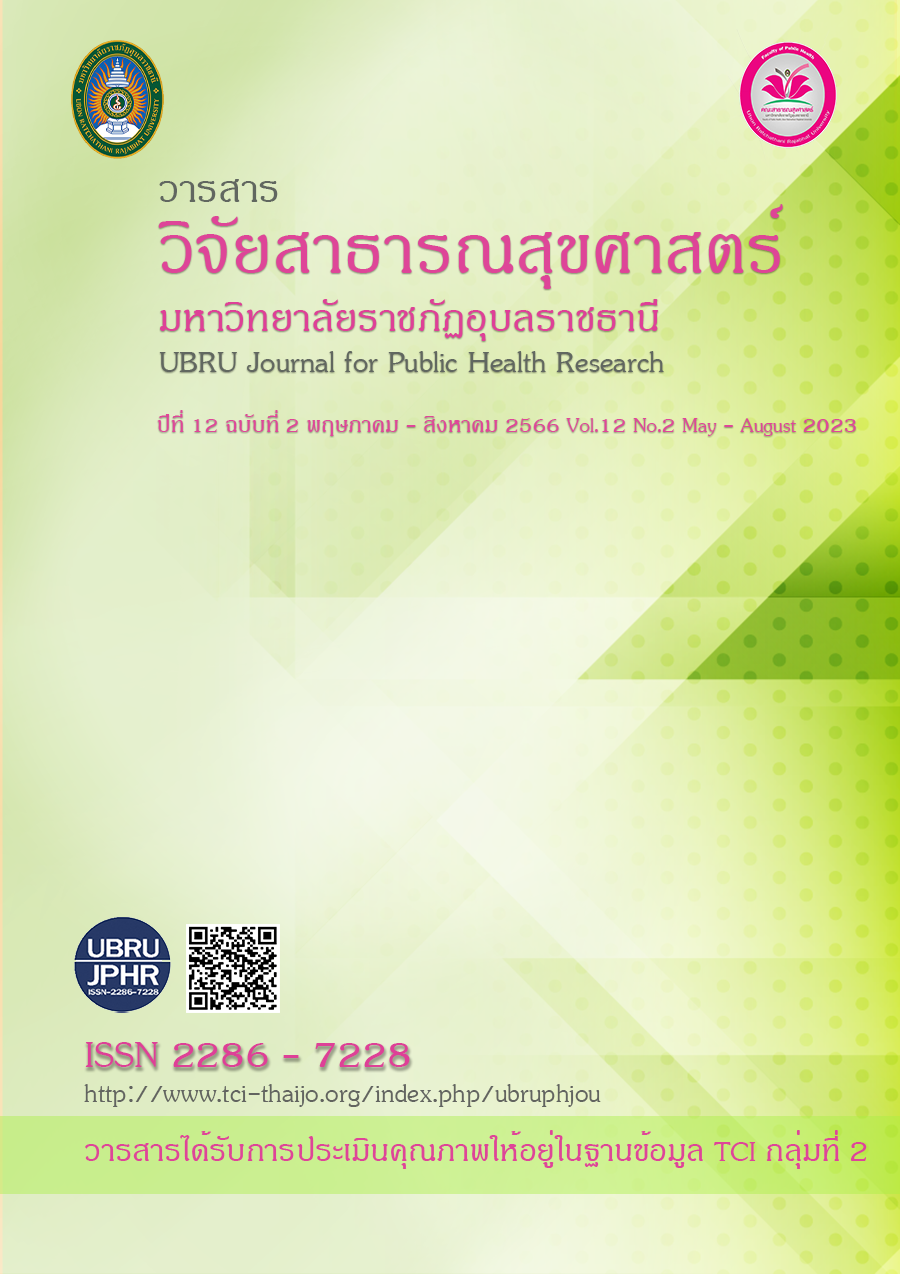Health effects of exposure to volatile organic compounds (VOCs)
Keywords:
Volatile organic compounds, source, health effectsAbstract
This research aims to investigate the origins and health impacts of exposure to Volatile Organic Compounds (VOCs), along with the legal regulatory measures for 9 specific types of VOCs, including Vinyl Chloride, 1,3 Butadiene, Dichloromethane, Chloroform, 1,2-Dichloroethane, Benzene, Trichloroethylene, 1,2-Dichloropropane, and Tetrachloroethylene. The study is based on a compilation of 12 sources, both domestically and internationally.
The study's findings reveal that VOCs primarily originate from industrial factories involved in various production processes. They act as starting materials, solvents, and byproducts of manufacturing processes, as well as emissions from combustion processes, such as vehicle engines. Locations exceeding standard levels for volatile organic compounds are primarily found in Bangkok, followed by Rayong, Khon Kaen, and Chiang Mai.
The VOCs that were found in the air exceeding standard levels include 1,3-Butadiene, Chloroform, 1,2-Dichloroethylene, and Benzene. The health impacts of exposure were identified as both acute and chronic, with three types of VOCs (Vinyl Chloride, 1,3 Butadiene, and Benzene) confirmed as Group 1 carcinogens in humans. Additionally, two types (Trichloroethylene and Tetrachloroethylene) were classified as Group 2A possible human carcinogens, and four types (Dichloromethane, Chloroform, 1,2-Dichloroethane, and 1,2-Dichloropropane) as Group 2B potentially carcinogenic.
In conclusion, it is recommended to monitor and control emissions from industrial factories to prevent exceeding standard levels of pollutants. Furthermore, advocating for the use of electric vehicles over fossil fuel-based vehicles is suggested as a means to mitigate pollution at its source. This approach aligns with efforts to control pollution and encourages the use of more environmentally friendly transportation options.
References
กรมควบคุมมลพิษ. (2566). รายงานสรุปสถานการณ์สารอินทรีย์ระเหยง่ายในบรรยากาศตามมาตรฐานคุณภาพอากาศในบรรยากาศ.ค้นเมื่อ 11 สิงหาคม 2565, จาก https://www.pcd.go.th/maptapoottype/2
จตุภัทร เมฆพายัพ. (2560). การวัดและการระบุลักษณะแหล่งกำเนิดของสารประกอบอินทรีย์ระเหยง่ายในนิคมอุตสาหกรรมมาบตาพุดของประเทศไทย โดยการใช้เทคนิคการวิเคราะห์หลายตัวแปร: ชลบุรี: มหาวิทยาลัยบูรพา.
ธัญญรัตน์ ไชยคราม,สุเพชร จิรขจรกุล. (2557). การประยุกต์ระบบสารสนเทศภูมิศาสตร์เพื่อการวิเคราะห์พื้นที่เสี่ยงภัยสารอินทรีย์ระเหยง่าย จังหวัดระยอง. วารสาร Thai Journal of Science and Technology (TJST). 3(3). 160-172
นริฏา ฟักแก้ว, สุรัตน์ บัวเลิศ (2558). การเปลี่ยนแปลงความเข้มข้นของสารอินทรีย์ระเหยง่ายที่มีผลต่อโอโซน บริเวณเขตเมือง, กรุงเทพมหานคร. วารสารวิจัย มข. (บศ.) 15 (1). 52-62.
ประกาศกระทรวงอุตสาหกรรม. (2555). กำหนดหลักเกณฑ์ และวิธีการปฏิบัติในการตรวจสอบและควบคุมการรั่วซึมของสารอินทรีย์ระเหยจากอุปกรณ์ใน โรงงานอุตสาหกรรม. กรุงเทพมหานคร: กระทรวงอุตสาหกรรม.
ประกาศกรมควบคุมมลพิษ. (2551). กำหนดค่าเฝ้าระวังสำหรับสารอินทรีย์ระเหยง่ายในบรรยากาศโดยทั่วไปในเวลา 24 ชั่วโมง. กรุงเทพมหานคร: กรมควบคุมมลพิษ
วราวุธ เสือดี. (2555). แนวทางการจัดการสารอินทรีย์ระเหย. กรุงเทพมหานคร: กลุ่มอุตสาหกรรมปิโตรเคมี สภาอุตสาหกรรมแห่งประเทศไทย.
American Conference of Governmental Industrial Hygienist. (2023). Journal of Occupational and Environmental Hygiene. ค้นเมื่อ 28 พฤษภาคม 2566, จาก https://www.acgih.org.
The International Agency for Research on Cancer. (2023). IARC MONOGRAPHS ON THE DENTIFICATION OF CARCINOGENIC HAZARDS TO HUMANS. ค้นเมื่อ 28 พฤษภาคม 2566, จาก https://monographs.iarc.who.int.
The National Institute for Occupational Safety and Health. (2023). NIOSH Pocket Guide to Chemical Hazards. ค้นเมื่อ 28 พฤษภาคม 2566, จาก https://www.cdc.gov/niosh/npg
Occupational and Environmental Medicine Center. (2023). Nopparat Hospital. ค้นเมื่อ 26 กุมภาพันธ์ 2566, จาก http://www.occmednop.com/nrhc/web/search/index.php
Occupational Safety and Health Administration. (2023). Regulations Standards. ค้นเมื่อ 28 พฤษภาคม 2566, จาก https://www.osha.gov/lawsregs/regulations
Downloads
Published
How to Cite
Issue
Section
License
Copyright (c) 2023 คณะสาธารณสุขศาสตร์ มหาวิทยาลัยราชภัฏอุบลราชธานี

This work is licensed under a Creative Commons Attribution-NonCommercial-NoDerivatives 4.0 International License.
เนื้อหาและข้อมูลในบทความที่ลงตีพิมพ์ในวารสารวารสารวิจัยสาธารณสุขศาสตร์ มหาวิทยาลัยราชภัฏอุบลราชธานี ถือเป็นข้อคิดเห็นและความรับผิดชอบของผู้เขียนบทความโดยตรงซึ่งกองบรรณาธิการวารสาร ไม่จำเป็นต้องเห็นด้วย หรือร่วมรับผิดชอบใดๆ
บทความ ข้อมูล เนื้อหา รูปภาพ ฯลฯ ที่ได้รับการตีพิมพ์ในวารสารนี้ ถือเป็นลิขสิทธิ์ของวารสารฯ หากบุคคลหรือหน่วยงานใดต้องการนำทั้งหมดหรือส่วนหนึ่งส่วนใดไปเผยแพร่ต่อหรือเพื่อกระทำการใดๆ จะต้องได้รับอนุญาตเป็นลายลักอักษรณ์จากบรรณาธิการวารสารนี้ก่อนเท่านั้น


